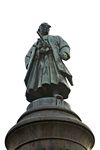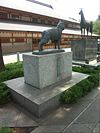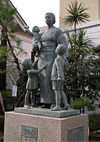Yasukuni Shrine
| Yasukuni Shrine 靖国神社 |
|
|---|---|
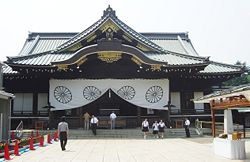 |
|
| The honden or main shrine | |
| Information | |
| Type | Imperial Shrine |
| Dedicated to | Those who lost their lives while serving Japan |
| Founded | June 1869 |
| Founder(s) | Emperor Meiji |
| Priest(s) | Nanbu Toshiaki |
| Address | 3-1-1, Kudankita, Chiyoda Tokyo 〒102-8246 |
| Phone | +81 (03) 3261-8326 |
| Website | Homepage |
Yasukuni Shrine (靖国神社 Yasukuni Jinja?, "Pacifying the Nation" Shrine) is a Shinto shrine located in Chiyoda, Tokyo, Japan. It is dedicated to the kami (spirits) of soldiers and others who died fighting on behalf of the Emperor of Japan.[1] Currently, its Symbolic Registry of Divinities lists the names of over 2,466,000 enshrined men and women whose lives were dedicated to the service of Imperial Japan, particularly to those killed in wartime.[2]
The shrine is a source of controversy. Of the almost 2.5 million enshrined, 1,068 have been convicted of war crimes by a post World War II court.[3] Despite popular media references that 14 Class-A war criminals are enshrined at Yasukuni, the figure is actually 12 because two of those enshrined, Yōsuke Matsuoka and Osami Nagano, actually died in prison before a verdict could be handed over.[4] The Yūshūkan—a shrine-owned history museum—has been accused of revisionism in its accounts of Japan's actions in World War II, as well as glorification of Japan's aggressive militaristic past.[5] Visits to the shrine by Japanese Cabinet members and Prime Ministers, in particular, have been the cause of protests at home as well as abroad. People's Republic of China, North Korea and South Korea have protested against various visits since 1985. The Taipei Times described the shrine in a 2008 article as "Japan's ultimate taboo subject."[6]
Contents |
History
Yasukuni Shrine, originally named Tōkyō Shōkonsha (東京招魂社?), was constructed in June 1869, by order of the Meiji Emperor, to commemorate the victims of the Boshin War who fought on the side of the Restoration.[7] It was one of several dozen shrines built throughout Japan at that time. In 1879, the shrine was renamed Yasukuni Jinja and became one of the principal shrines associated with State Shinto, as well as the primary national shrine for commemorating Japan's war dead. The name Yasukuni, a quotation from the classical-era Chinese text Zuo Zhuan, literally means "Pacifying the Nation" and was chosen by the Meiji Emperor.[8] Shinto rites are performed at the shrine, which, according to Shinto belief, houses the kami, or spirits, of all Japanese, former colonial subjects (Korean and Taiwanese) and civilians who died in service of the emperor while participating in the nation's conflicts that occurred prior to 1951.
After Japan's defeat in World War II, the US-led Occupation Authorities issued the Shinto Directive. This directive ordered the separation of church and state and effectively put an end to State Shinto. Yasukuni Shrine was then forced either to become a secular government institution or a religious institution that is independent from the Japanese government. It was decided that the shrine would become a privately funded religious institution. Since that decision in 1946, Yasukuni Shrine has continued to be privately funded and operated.[9]
Enshrined kami
According to Shinto beliefs, by enshrining kami Yasukuni Shrine provides a permanent residence for the spirits of those who have fought on behalf of the emperor. Unlike a traditional Shinto shrine in which each kami occupies its own seat in the shrine, Yasukuni has all enshrined kami occupying the same single seat.[10]
There are over 2,466,000 enshrined kami currently listed in the Yasukuni's Symbolic Registry of Divinities. This list includes soldiers, as well as women and students who were involved in relief operations in the battlefield or worked in factories for the war effort.[2] Enshrinement is not exclusive to people of Japanese descent. Currently, Yasukuni Shrine has enshrined 27,863 Taiwanese and 21,181 Koreans.[11]
Eligible categories
As a general rule, the enshrined are limited to those who died while serving Japan during armed conflicts, so civilians who died during wars are not included, apart from a handful of exceptions. In order to be considered to be added to the list of enshrined, the dead must fall into at least one of the eligible categories:
- Military personnel, and civilians employed by the military, who were:
- killed in action, or died as a result of wounds or illnesses sustained while on duty outside the Home Islands (and within the Home Islands after September 1931)
- missing and presumed to have died as a result of wounds or illnesses sustained while on duty
- died as a result of war crime tribunals which have been ratified by the San Francisco Peace Treaty
- Civilians who participated in combat under the military and died from resulting wounds or illnesses (includes residents of Okinawa)
- Civilians who died, or are presumed to have died, in Soviet labor camps after the war
- Civilians who were officially mobilized or volunteered (such as factory workers, mobilized students, Japanese Red Cross nurses and anti air-raid volunteers) who were killed while on duty
- Crew who were killed aboard Merchant Navy vessels
- Crew who were killed due to the sinking of exchange ships (i.e. Awa Maru)
- Okinawan schoolchildren evacuees who were killed (i.e. the sinking of Tsushima Maru)
- Officials of the governing bodies of Karafuto Prefecture, Kwantung Leased Territory, Governor-General of Korea and Governor-General of Taiwan
Although new names of World War II-dead are added to the shrine every year, no deaths due to conflicts occurring since Japan signed the San Francisco Peace Treaty in 1951 have qualified for enshrinement. Therefore, the shrine does not include members of the Japanese Self-Defense Forces who have died on duty in subsequent conflicts.
Enshrinement is carried out unilaterally by the shrine. Some families from foreign countries such as South Korea have requested that their relatives be delisted on the grounds that enshrining someone against their beliefs in life constitutes an infringement of the Constitution.[12] The Yasukuni priesthood, however, has stated that once a kami is enshrined, it has been 'merged' with the other kami occupying the same seat and therefore cannot be separated.
Kami by conflict
Japan has participated in ten other conflicts since the Boshin War in 1869. The following table chronologically lists the number of kami enshrined at Yasukuni Shrine (as of October 17, 2004) from each of these conflicts.
| Conflict | Description | Year(s) | # of Enshrined | Notes |
|---|---|---|---|---|
| Boshin War and Meiji Restoration | Japanese civil war | 1867–1869 | 7,751 | [13] |
| Satsuma Rebellion | Japanese civil war | 1877 | 6,971 | [13] |
| Taiwan Expedition of 1874 | Conflict with Paiwan people (Taiwanese aborigines) | 1874 | 1,130 | [13] |
| First Sino-Japanese War | Conflict with Qing-China over Korea | 1894–95 | 13,619 | [13] |
| Boxer Uprising | Eight-Nation Alliance's invasion of China | 1901 | 1,256 | [13] |
| Russo-Japanese War | Conflict with Russian Empire over Korea and Manchuria | 1904–05 | 88,429 | [13] |
| World War I | Conflict with German Empire (Central Powers) over Shandong, a Chinese province | 1914–1918 | 4,850 | [13] |
| Jinan Incident | Conflict with China (Kuomintang) over Jinan, a Chinese sub-provincial city | 1928 | 185 | [13] |
| Mukden Incident | Leading to the occupation of Manchuria | 1931 | 17,176 | [14][13] |
| Second Sino-Japanese War | Conflict with China | 1937–1941 | 191,250 | [14][13] |
| World War II | Conflict with the Allied forces and involvement in the Pacific theater | 1941–1945 | 2,133,915 | [14][13] |
| Total | 2,466,532 | [13] | ||
The shrine does not include the Tokugawa shogunate's forces (particularly from the Aizu domain and Satsuma Province) who died during the Boshin War and Satsuma Rebellion because they are considered enemies of the emperor. This exclusion, which includes the ancestors of current Chief Priest Nanbu Toshiaki, is deeply resented in both areas.
Controversy
Enshrinement of war criminals
One of the controversies arises out of the enshrinement of World War II war criminals. According to documents released by the National Diet Library of Japan in 2007, Health and Welfare Ministry officials and Yasukuni representatives officially met and agreed on 31 January, 1969, that 1,068 convicted war criminals were "able to be honored" with enshrinement at Yasukuni. After the meeting, it was specifically decided to not publicly announce the criminals' enshrinement.[15] In 1978, the kami of 1,068 convicted war criminals, including 14 convicted Class-A war criminals ("crimes against peace") were secretly enshrined at Yasukuni.[3]
Since the enshrinement, there have been calls from different groups of people to remove the war criminals, who include Imperial Japanese Army General Hideki Tojo,[15] from Yasukuni Shrine. These calls, however, have not been fulfilled. Shrine officials have stated that unlike traditional Shinto shrines, all enshrined kami are immediately combined and therefore become impossible to be separated for removal.[10] In addition, the family of Prime Minister Tojo Hideki has refused to sign a petition for the removal of seven Class-A war criminals' names from the shrine.[10]
In recent years, South Korea has pressed Japan to build a new, secular war memorial to replace Yasukuni, but currently there are no definitive plans for such a monument.[16]
Yūshūkan

Yasukuni Shrine operates a museum of the history of Japan called the Yūshūkan, which honors Japanese war heroes. Although the Yūshūkan displays items relating to early military conflicts, such as the Meiji Restoration and the Satsuma Rebellion, the museum focuses primarily on the events surrounding World War II.[5]
The museum has been criticized as presenting a revisionist interpretation of World War II.[5] The museum highlights heroic war stories and kamikaze pilots, but does not mention incidents such as Japan using comfort women and the war crimes in Manchukuo.[5] A documentary-style video gives visitors the perspective that Japan was not at fault in the Nanking Massacre and that Japanese leaders were wrongly convicted at the Tokyo War Crimes Trials.[5] The museum shows Japan as an Asian liberator, provoked into war by European and U.S. officials, who choked the incoming supply of raw materials to the resource-poor nation. Many believe that the museum is a symbol of Japanese colonialism and nationalism, and is a reminder that Japan has been slow to apologize for wartime crimes.[5]
Politicians' visits
As a result of the enshrinement of the war criminals In Yasukuni, a controversy has arisen regarding Japanese politicians' right to visit and worship at Yasukuni Shrine.
This issue first surfaced when Emperor Hirohito refused to visit the shrine from 1978 until his death in 1989.[17] According to a memorandum released in 2006 kept by Imperial Household Agency Grand Steward Tomohiko Tomita, Hirohito stated that the reason he stopped visiting the shrine was because of the decision to enshrine Class-A war criminals such as Yosuke Matsuoka and Toshio Shiratori.[18] Since his 1978 decision, no Japanese emperor has visited the Yasukuni Shrine.
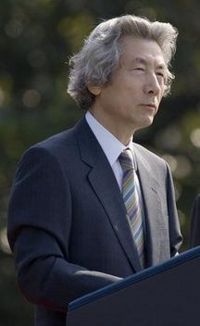
While an emperor has not visited the shrine since 1978, Japanese politicians, including Japanese Prime Ministers and other Japanese Cabinet members, have caused considerable controversy by visiting Yasukuni. Prime Minister Junichiro Koizumi was one of the most outspoken and controversial visitors. On October 17, 2005, for example, Koizumi visited the shrine for the fifth time since taking office. Although he claimed that his visit was a private affair, it came only days before Japanese Foreign Minister Nobutaka Machimura was scheduled to visit Chinese officials in Beijing to strengthen Sino-Japanese relations. Considering the shrine a glorification of Japan's past military aggression, the People's Republic of China responded by canceling the scheduled visit.[19]
Koizumi's annual visits to Yasukuni continued to draw criticism from around the world. During the 2005 APEC summit in Busan, South Korea, Chinese Foreign Minister Li Zhaoxing likened Koizumi's visits to "German leaders [visiting] (memorials) related to Hitler and Nazis."[20] In 2006, Henry Hyde, chairman of the United States House Committee on Foreign Affairs, stated that Koizumi would embarrass the United States Congress and offend American veterans of World War II if he were to give a Congressional speech after making another visit to Yasukuni.[21]
Koizumi's expected successor, Shinzo Abe, had visited the shrine in April 2006 before he took office. Although this visit concerned both Chinese and South Korean governments,[22] Abe remained vague as to whether he had visited or would visit the shrine in the future. Subsequent events have led some to suggest that a compromise on the issue was reached with China.[23] Abe publicly supported his predecessor's visits to the shrine, but he did not visit the shrine during his term as prime minister.[24]
On June 7, 2007 former President of the Republic of China Lee Teng-hui visited the Shrine to pay tribute to his older brother who died in the Japanese Imperial Navy; he too volunteered as a Japanese Imperial Army officer.
The former Prime Minister Yasuo Fukuda vowed never to visit the shrine, a commitment applauded by Japan's Asian neighbors.[25] Fukuda's open political opposition to the shrine has helped improve relations with China, and North and South Korea.[26] Other politicians have continued to visit the shrine; a group of 62 Diet members from the Liberal Democratic Party and the People's New Party, including former farm minister Shimamura and Eriko Yamatani, a special adviser to prime minister Fukuda, visited the shrine on 22 April 2008. [27]
Precinct
There are a multitude of facilities within the 6.25 hectare grounds of the shrine, as well as several structures along the 4 hectare causeway. Though other shrines in Japan also occupy large areas, Yasukuni is different because of its recent historical connections. The Yūshūkan museum and several bronze statues are just a few of the features that differentiate Yasukuni from other Shinto shrines. The following lists describe many of these facilities and structures.
Shrine structures

On the shrine grounds, there are several important religious structures. The shrine's haiden, Yasukuni's main prayer hall where worshipers come to pray, was originally built in 1901 in order to allow patrons to pay their respects and offer money. This building's roof was renovated in 1989. The white screens hanging off the ceiling are changed to purple ones on ceremonial occasions.[28]
The honden is the main shrine where Yasukuni's enshrined kami reside. Built in 1872 and refurbished in 1989, it is where the shrine's priests perform Shinto rituals. The building is generally closed to the public.[29]
The building located directly behind the honden to the east is know as the Reijibo Hōanden. It houses the Symbolic Registry of Divinities (霊璽簿 Reijibo?)—a handmade Japanese paper document that lists the names of all the kami enshrined and worshiped at Yasukuni Shrine. It was built of quakeproof concrete in 1972 with a private donation from Emperor Hirohito.[30]
In addition to Yasukuni's main shrine buildings, there are also two peripheral shrines located on the precinct. Motomiya is a small shrine that was first established in Kyoto by sympathizers of the imperial loyalists that were killed during the early weeks of the civil war that erupted during the Meiji Restoration. Seventy years later, in 1931, it was moved directly south of Yasukuni Shrine's honden. Its name, Motomiya ("Original Shrine"), references the fact that it was essentially a prototype for the current Yasukuni Shrine.[31] The second peripheral shrine is the Chinreisha. This small shrine was constructed in 1965 directly south of the Motomiya. It is dedicated to those not enshrined in the honden—those killed by wars worldwide, regardless of nationality. It has a festival on July 13.[32]
Torii and gates
 |
||
|
Chumon Torii
|
Ishi Torii
|
There are several different torii and gates located on both the causeway and shrine grounds. When moving through the grounds from east to west, the first torii visitors encounter is the Daiichi Torii. This large steel structure is the largest torii in Japan and was first erected in 1921 to mark the main entrance to the shrine. It stands approximately 25 meters tall and 34 meters wide and is the first torii. The current iteration of this torii was erected in 1974 after the original was removed in 1943 due to weather damage.[33]
The Daini Torii is the second torii encountered on the westward walk to the shrine. It was erected in 1887 and is the largest bronze torii in Japan.[34] Immediately following the Daini Torii is the shinmon. A 6-meter tall hinoki cypress gate, it was first built in 1934 and restored in 1994. Each of its two doors bears a Chrysanthemum Crest measuring 1.5 meters in diameter.[35] West of this gate is the Chumon Torii, the last torii visitors must pass underneath before reaching Yasukuni's haiden. It was recently rebuilt of cypress harvested in Saitama Prefecture in 2006.[36]
In addition to the three torii and one gate that lead to the main shrine complex, there are a few others that mark other entrances to the shrine grounds. The Ishi Torii is a large stone torii located on the south end of the main causeway. It was erected in 1932 and marks the entrance to the parking lots.[37] The Kitamon and Minamimon are two areas that mark the north and south entrances, respectively, into the Yasukuni Shrine complex. The Minamimon is marked by a small wooden gateway.
Memorials
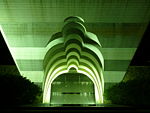 |
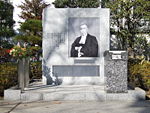 |
|
|
Irei no Izumi
|
Monument of Justice Radha Binod Pal
|
- Irei no Izumi: This modern looking monument is a spring dedicated to those who suffered from or died of thirst in battle.[38]
- Statue of Ōmura Masujirō: Created by Okuma Ujihiro in 1893, this statue is Japan's first western-style bronze statue. It honors Ōmura Masujirō, a man who is known as the "Father of the Modern Japanese Army."[39]
- Statue of Kamikaze Pilot: A bronze statue representing a kamikaze pilot stands to the left of the Yūshūkan's entrance. A small plaque to the left of the statue donated by the Tokkōtai Commemoration Peace Memorial Association in 2005 details the 5,843 men who died while executing attacks for the Tokkōtai.[40]
- Statues of Dog, Horse & Carrier Pigeon: These three life-sized bronze statues were all donated at different times during the second half of the 20th century. The first of the three that was donated, the horse statue was placed at Yasukuni Shrine in 1958 to honor the memory of the horses that served in the Japanese military. Presented in 1982, this statue depicting a pigeon atop a globe honors homing pigeons used by the military. The last statue, donated in March 1992, depicts a German shepherd and honors the soldiers' canine comrades.[41] Opened, full bottles of water are often left at these statues.
- Statue of War Widow: This statue honors all mothers who were forced to raise children in the absence of their husbands who were killed in war. It was donated to the shrine in 1974 by these mothers' children.[42]
- Monument of Dr. Pal: This recent monument was erected at Yasukuni Shrine in 2005. It honors Indian judge Radhabinod Pal, the lone justice on the International Military Tribunal for the Far East's trials of Japanese war crimes committed during World War II to find all the defendants not guilty.[43]
Other buildings and structures

- Yūshūkan: Originally built in 1882, this museum located to the north of the main hall houses many war relics, including a Zero Fighter plane and Kaiten suicide torpedo. It glorifies sacrifice and bravery, while making little mention of human suffering on both sides. More controversially, it states that the Pacific War was a war fought by Japan in self-defense. The former prime minister, Junichiro Koizumi, has had to clarify in the Diet that Yūshūkan's interpretation of history differs to that of the government.
- Dove Cote: Almost 300 white doves live and are bred in a special dove cote located on the grounds of Yasukuni Shrine.[44]
- Shinchi Teien: This Japanese style strolling garden was created in the early Meiji Era. Its centerpiece is a small waterfall located in a serene pond. It was refurbished in 1999.[45]
- Sumo Ring: In 1869, a sumo wrestling exhibition was held at Yasukuni Shrine in order to celebrate the shrine's establishment. Since then, exhibitions involving many professional sumo wrestlers, including several grand champions (yokozuna) take place at the Spring Festival almost every year. The matches are free of charge.[46]
See also
- List of Shinto shrines
- Japanese nationalism
- Anti-Japanese sentiment
- Chinese nationalism
- Korean nationalism
- Anti-Japanese sentiment in Korea
References
- ↑ "History". Retrieved on 2008-03-23.
- ↑ 2.0 2.1 "Deities". Retrieved on 2008-04-13.
- ↑ 3.0 3.1 "Where war criminals are venerated". CNN.com (2003-01-04). Retrieved on 2008-04-13.
- ↑ http://japanfocus.org/products/topdf/2443
- ↑ 5.0 5.1 5.2 5.3 5.4 5.5 "Yasukuni Jinja Yushukan". Retrieved on 2008-04-13.
- ↑ "Reel News." Taipei Times. Friday May 9, 2008.
- ↑ "Yasukuni Shrine, Tokyo". Sacred Destinations. Retrieved on 2008-03-23.
- ↑ "Yomiuri Shimbun: 基礎からわかる靖国神社問題】Q 戦前、戦後 どんな役割?". Retrieved on 2007-01-30.
- ↑ Tetsuya, Takahashi. "Yasukuni Shrine at the Heart of Japan’s National Debate". Japan Focus. Retrieved on 2008-03-23.
- ↑ 10.0 10.1 10.2 Takenaka, Akiko (2007-06-10). "Enshrinement Politics: War Dead and War Criminals at Yasukuni Shrine". Znet. Retrieved on 2008-04-13.
- ↑ Nobumasa, Tanaka (2004-05-27). "Yasukuni Shrine and the Double Genocide of Taiwan's Indigenous Atayal: new court verdict". Znet. Retrieved on 2008-04-13.
- ↑ "Suit filed over Korean soldiers enshrined at Yasukuni Shrine" (2001-06-29). Retrieved on 2008-08-10.
- ↑ 13.00 13.01 13.02 13.03 13.04 13.05 13.06 13.07 13.08 13.09 13.10 13.11 "靖国神社" (in Japanese) (2004-10-17). Retrieved on 2008-04-13.
- ↑ 14.0 14.1 14.2 Breen, John (2005-06-03). "Yasukuni Shrine: Ritual and Memory". Japan Focus. Retrieved on 2008-04-13.
- ↑ 15.0 15.1 "Paper: Yasukuni, state in '69 OK'd war criminal inclusion". The Japan Times (2007-03-29). Retrieved on 2008-04-13.
- ↑ "S. Korea to seek memorial to replace Yasukuni Shrine". Kyodo News International (2004-02-09). Retrieved on 2008-04-13.
- ↑ Brasor, Philip (2006-08-20). "Notes on Yasukuni and a week that will live in infamy". The Japan Times. Retrieved on 2008-04-13.
- ↑ "Hirohito visits to Yasukuni stopped over war criminals". The Japan Times (2006-07-21). Retrieved on 2008-04-13.
- ↑ "China cancels meeting with Machimura". The Japan Times (2005-10-19). Retrieved on 2008-04-13.
- ↑ "China playing the Hitler card". The Japan Times (2005-11-16). Retrieved on 2008-04-13.
- ↑ Nakata, Hiroko (2006-05-17). "Bid to address Congress has Yasukuni proviso". The Japan Times. Retrieved on 2008-04-13.
- ↑ "China expresses concern over reported Abe visit to Yasukuni". Yahoo! News (2006-08-04). Retrieved on 2008-04-13.
- ↑ York, Geoffrey (2006-10-06). "Japan, China reach agreement over shrine". University of Alberta. Retrieved on 2008-04-13.
- ↑ "Profile: Shinzo Abe". BBC News (2007-09-12). Retrieved on 2008-04-13.
- ↑ "Fukuda leads Japan PM race, won't visit Yasukuni". China Daily (2007-09-16). Retrieved on 2008-04-13.
- ↑ "All quiet on the eastern front?". The Economist (2008-02-26). Retrieved on 2008-04-13.
- ↑ Lawmakers visit Yasukuni festival, http://search.japantimes.co.jp/cgi-bin/nn20080423a5.html
- ↑ "Haiden (Main Hall)". Yasukuni Shrine. Retrieved on 2008-03-23.
- ↑ "Honden (Main Shrine)". Yasukuni Shrine. Retrieved on 2008-03-23.
- ↑ "Reijibo Hoanden (Repository for the Symbolic Registers of Divinities)". Yasukuni Shrine. Retrieved on 2008-03-23.
- ↑ "Motomiya(Original Shrine)". Yasukuni Shrine. Retrieved on 2008-03-23.
- ↑ "Chinreisha (Spirit-Pacifying Shrine)". Yasukuni Shrine. Retrieved on 2008-03-23.
- ↑ "Daiichi Torii (First Shrine Gate or Great Gate)". Yasukuni Shrine. Retrieved on 2008-03-23.
- ↑ "Daini Torii (Second Shrine Gate)". Yasukuni Shrine. Retrieved on 2008-03-23.
- ↑ "Shinmon (Main Gate)". Yasukuni Shrine. Retrieved on 2008-03-23.
- ↑ "Chumon Torii (Third Shrine Gate)". Yasukuni Shrine. Retrieved on 2008-03-23.
- ↑ "Ishi Torii (Stone Shrine Gate)". Yasukuni Shrine. Retrieved on 2008-03-24.
- ↑ "Day 7 - Independent Activities". Japan Fulbright Memorial Fund. Retrieved on 2008-03-24.
- ↑ "Statue of Omura Masujiro". Yasukuni Shrine. Retrieved on 2008-03-24.
- ↑ "Kamikaze Pilot Statue". Kamikaze Images. Retrieved on 2008-05-20.
- ↑ "Statues honoring horses, carrier pigeons and dogs killed in war service". Yasukuni Shrine. Retrieved on 2008-03-24.
- ↑ "Statue of War Widow with Children". Yasukuni Shrine. Retrieved on 2008-03-24.
- ↑ "Monument of Dr. Pal". Yasukuni Shrine. Retrieved on 2008-03-28.
- ↑ "Dove cote". Yasukuni Shrine. Retrieved on 2008-03-28.
- ↑ "Shinchi Teien". Yasukuni Shrine. Retrieved on 2008-03-28.
- ↑ "Sumo Ring". Yasukuni Shrine. Retrieved on 2008-03-28.
Additional notes
- Nelson, John. "Social Memory as Ritual Practice: Commemorating Spirits of the Military Dead at Yasukuni Shinto Shrine". Journal of Asian Studies 62, 2 (May 2003): 445-467.
- Pye, Michael: Religion and Conflict in Japan with Special Reference to Shinto and Yasukuni Shrine. In: Diogenes 50:3 (2003), S. 45-59.
- Saaler, Sven: Politics, Memory and Public Opinion. München, iudicium, 2005.
Further reading
- Breen, John. "The dead and the living in the land of peace: a sociology of the Yasukuni shrine". Mortality 9, 1 (February 2004): 76-93.
- Nelson, John. "Social Memory as Ritual Practice: Commemorating Spirits of the Military Dead at Yasukuni Shinto Shrine". Journal of Asian Studies 62, 2 (May 2003): 445-467.
- Sheftall, M.G. (2005). Blossoms in the Wind: Human Legacies of the Kamikaze. NAL Caliber. pp. 480pp. ISBN 0-451-21487-0. http://www.amazon.com/dp/B000EUKRAY/.
- Sturgeon, William Daniel (August 2006). Japan's Yasukuni Shrine: Place of Peace or Place of Conflict? Regional Politics of History and Memory in East Asia. Dissertation.com. ISBN 1-58112-334-5.
The controversy
- Ijiri, Hidenori. "Sino-Japanese Controversies since the 1972 Diplomatic Normalization". China Quarterly 124 (Dec 1990): 639–661.
- Shibuichi, Daiki. "The Yasukuni Dispute and the Politics of Identity of Japan: Why All the Fuss?" Asian Survey 45, 2 (March-April 2005): 197–215.
- Tamamoto, Masaru. "A Land Without Patriots: The Yasukuni Controversy and Japanese Nationalism". World Policy Journal 18, 3 (Fall 2001): 33–40.
- Yang, Daqing. “Mirror for the future of the history card? Understanding the ‘history problem’” in Chinese-Japanese Relations in the Twenty-first Century: Complementarity and Conflict, edited by Marie Söderberg, 10–31. New York, NY: Routledge, 2002.
External links
- Yasukuni Shrine official website (English)
- Official page of the Japanese Foreign Ministry on the Yasukuni visits of PM Koizumi
- A feature from The Japan Times on the chief priest of Yasukuni and his views of PM visits
- Yasukuni Jinja photos and slideshow on the 60th anniversary of Japan's surrender (2005)
- Discussion of the impact of Prime Ministerial visits to Yasukuni Shrine
- Audio/Video recordings of Professor Tetsuya Takahashi discussing his book Postwar Japan on the Brink: Militarism, Colonialism, Yasukuni Shrine at the University of Chicago
